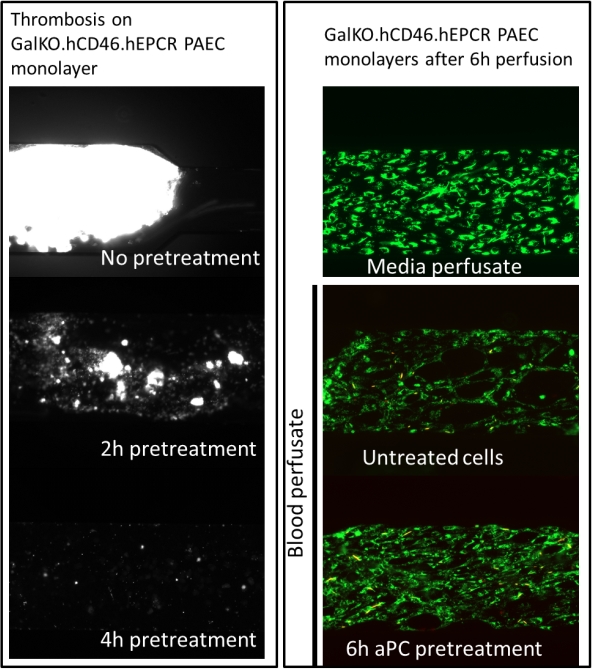aPC Pretreatment of hEPCR-Expressing PAECs Attenuates Endothelial Cell Damage and Thrombosis.
1Cardiac Surgery, University of Maryland School of Medicine, Baltimore, MD
2Revivicor, Inc, Blacksburg, VA.
Meeting: 2016 American Transplant Congress
Abstract number: D77
Keywords: Anticoagulation, Xenotransplantation
Session Information
Session Name: Poster Session D: Chimerism/Stem Cells, Cellular/Islet Transplantation, Innate Immunity, Chronic Rejection
Session Type: Poster Session
Date: Tuesday, June 14, 2016
Session Time: 6:00pm-7:00pm
 Presentation Time: 6:00pm-7:00pm
Presentation Time: 6:00pm-7:00pm
Location: Halls C&D
Introduction
Activated Protein C (aPC), acting primarily through the human endothelial protein C receptor (hEPCR), mediates anti-thrombotic and anti-inflammatory cytoprotective effects in humans. We hypothesized that treatment of hEPCR expressing porcine endothelial cells (ECs) with recombinant aPC would attenuate xenogeneic EC injury.
Methods
Confluent GalKO.hCD46.hEPCR porcine aortic EC (PAEC) monolayers in microfluidic channels were pretreated with 0.02[micro]g/mL recombinant aPC (raPC) several hours prior to perfusion with heparinized human blood. Thrombosis, viability, and endothelial surface area coverage were calculated by fluorescent analysis using image processing software.
Results
raPC pretreatment (Rx) of ECs reduced platelet adhesion (45.6±16.2 % surface area (SA) coverage in untreated hEPCR+ cells) to 27.3±10.2% after 2 h exposure to aPC (p=.085 vs untreated), 6.6±1.6% after 4h (p=.003), and 5.3±1.8% after 6h (p=0.0025). Relative to untreated monolayers (63.45±30 au), platelet aggregation also decreased with increasing duration of aPC Rx from 2h (34.6±16.1 au, p=0.13) to 6h (26.1±8.23 au, p=0.05). When perfused with human blood, untreated GalKO.hCD46.hEPCR PAEC monolayers showed cellular damage (7.37±1.81 PI+ cells/hpf, vs none with medium) and reduced surface area coverage (75.5±3.5%, vs 100% with medium). Six hour Rx with raPC was associated with significantly fewer PI+ cells (3±1.23 cells/hpf, p=0.0003 vs untreated EC), and significantly higher EC surface coverage (87.3±2.9 percent, p<0.0001).  Prevention of increased permeability of hEPCR+ PAEC after human thrombin exposure, measured by electrical impedance (xCELLigence), correlated directly with increasing duration of EC pretreatment with aPC. Effects of aPC Rx were only seen with pAECs that express hEPCR.
Prevention of increased permeability of hEPCR+ PAEC after human thrombin exposure, measured by electrical impedance (xCELLigence), correlated directly with increasing duration of EC pretreatment with aPC. Effects of aPC Rx were only seen with pAECs that express hEPCR.
Conclusions
aPC pretreatment of hEPCR-expressing PAEC monolayers significantly reduced clot initiation, thrombus propagation, and endothelial cell injury in a time and hEPCR-dependent manner. Future work will confirm these effects using EPCR blocking antibody.
CITATION INFORMATION: Laird C, French B, Harris D, Chang X, Ayares D, Pierson R, Azimzadeh A. aPC Pretreatment of hEPCR-Expressing PAECs Attenuates Endothelial Cell Damage and Thrombosis. Am J Transplant. 2016;16 (suppl 3).
To cite this abstract in AMA style:
Laird C, French B, Harris D, Chang X, Ayares D, Pierson R, Azimzadeh A. aPC Pretreatment of hEPCR-Expressing PAECs Attenuates Endothelial Cell Damage and Thrombosis. [abstract]. Am J Transplant. 2016; 16 (suppl 3). https://atcmeetingabstracts.com/abstract/apc-pretreatment-of-hepcr-expressing-paecs-attenuates-endothelial-cell-damage-and-thrombosis/. Accessed December 27, 2025.« Back to 2016 American Transplant Congress
